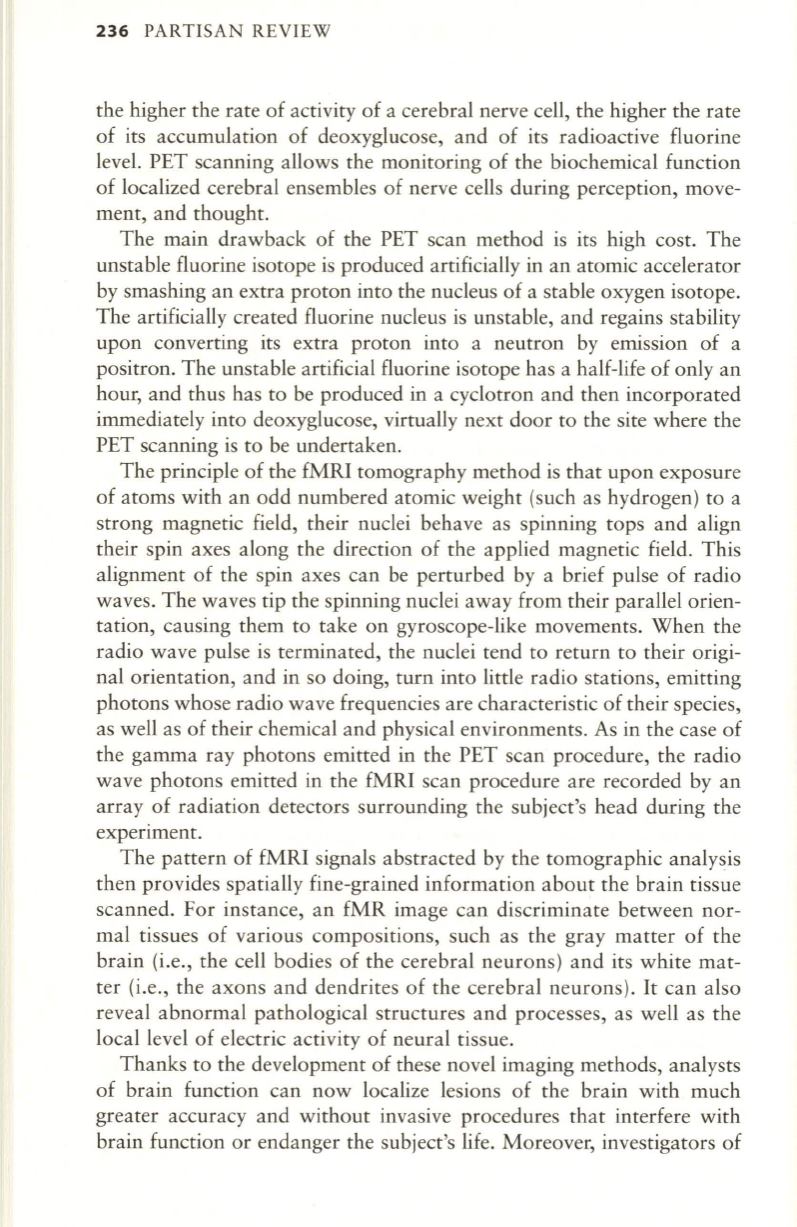
236
PARTISAN REVIEW
the higher the rate of activity of a cerebral nerve cell, the higher the rate
of its accumulation of deoxyglucose, and of its radioactive fluorine
level. PET scanning allows the monitoring of the biochemical function
of localized cerebral ensembles of nerve cells during perception, move–
ment, and thought.
The main drawback of the PET scan method is its high cost. The
unstable fluorine isotope is produced artificially in an atomic accelerator
by smashing an extra proton into the nucleus of a stable oxygen isotope.
The artificially created fluorine nucleus is unstable, and regains stability
upon converting its extra proton into a neutron by emission of a
positron. The unstable artificial fluorine isotope has a half-life of only an
hour, and thus has to be produced in a cyclotron and then incorporated
immediately into deoxyglucose, virtually next door to the site where the
PET scanning is to be undertaken.
The principle of the fMRI tomography method is that upon exposure
of atoms with an odd numbered atomic weight (such as hydrogen) to a
strong magnetic field, their nuclei behave as spinning tops and align
their spin axes along the direction of the applied magnetic field. This
alignment of the spin axes can be perturbed by a brief pulse of radio
waves . The waves tip the spinning nuclei away from their parallel orien–
tation, causing them to take on gyroscope-like movements. When the
radio wave pulse is terminated, the nuclei tend to return to their origi–
nal orientation, and in so doing, turn into little radio stations, emitting
photons whose radio wave frequencies are characteristic of their species,
as well as of their chemical and physical environments. As in the case of
the gamma ray photons emitted in the PET scan procedure, the radio
wave photons emitted in the fMRI scan procedure are recorded by an
array of radiation detectors surrounding the subject'S head during the
experiment.
The pattern of fMRI signals abstracted by the tomographic analysis
then provides spatially fine-grained information about the brain tissue
scanned. For instance, an fMR image can discriminate between nor–
mal tissues of various compositions, such as the gray matter of the
brain (i .e., the cell bodies of the cerebral neurons) and its white mat–
ter (i.e., the axons and dendrites of the cerebral neurons) .
It
can also
reveal abnormal pathological structures and processes, as well as the
local level of electric activity of neural tissue.
Thanks to the development of these novel imaging methods, analysts
of brain function can now localize lesions of the brain with much
greater accuracy and without invasive procedures that interfere with
brain function or endanger the subject's life. Moreover, investigators of


